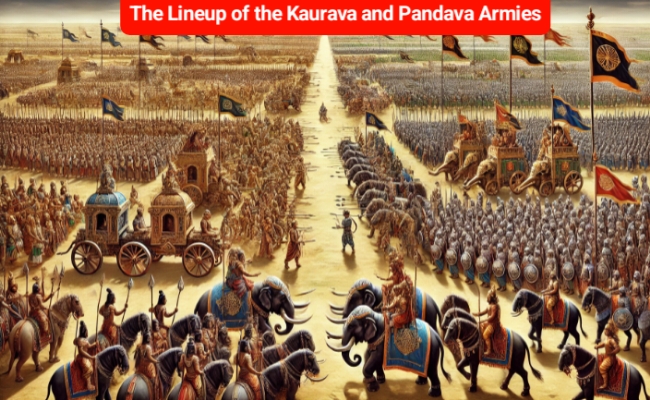The Lineup of the Kaurava and Pandava Armies: An In-Depth Look into the Battlefield Formations of the Mahabharata, The battle of Kurukshetra was fought between the cousins — the Kauravas, led by the eldest brother Duryodhana,
The Lineup of the Kaurava and Pandava Armies
The Mahabharata, one of the two great epics of ancient India, describes the epic war fought between the Kauravas and the Pandavas on the battlefield of Kurukshetra. This war, spanning eighteen days, is not only a grand narrative of valor, loyalty, and divine intervention but also a fascinating study of military strategy and formation. In this article, we’ll delve deep into the strategic formations of both armies, exploring the crucial role these lineups played in one of the most dramatic conflicts in ancient mythology.
The Context of the Battle
The battle of Kurukshetra was fought between the cousins — the Kauravas, led by the eldest brother Duryodhana, and the Pandavas, led by Yudhishthira. The battle was triggered by a long-standing enmity, compounded by the Kauravas’ refusal to return the Pandavas’ share of the kingdom after their exile. This war drew in allies from across the subcontinent, with kings, warriors, and legendary figures rallying to one side or the other, each bringing unique strengths to the battlefield.
The conflict was not merely a contest of strength but a showcase of military wisdom and carefully coordinated tactics. Both armies lined up each day in specific battle formations, which were reshaped and restructured based on the flow of events, reflecting strategic foresight and responding to unforeseen challenges.
Day-by-Day Lineup and Formation
Each day, the armies adopted different formations or vyuhas, designed to exploit their strengths or defend against enemy advances. These vyuhas were geometric configurations that dictated the movement and positioning of troops, with each formation crafted for a specific purpose. Here’s a breakdown of some notable formations from the eighteen days of the war:
1. Day 1: Vajra Vyuha and Krauncha Vyuha
On the first day, the Kauravas arranged their forces in the Vajra Vyuha (Diamond Formation), symbolizing strength and resilience. This formation allowed soldiers to withstand initial attacks with minimal casualties, especially beneficial in the opening stages of a prolonged conflict. The Pandavas, however, formed their troops in the Krauncha Vyuha (Heron Formation), an offensive arrangement meant to penetrate the Kaurava defenses. The heron-like shape gave the Pandava forces an attacking edge, pushing forward in a pointed formation to break the Kaurava lines.
2. Day 2: Garuda Vyuha and Trishula Vyuha
The Garuda Vyuha, or Eagle Formation, was a defensive arrangement resembling an eagle’s wingspan. On the second day, Bhishma, the Kaurava commander, deployed his forces in this formation. The Pandavas responded with the Trishula Vyuha (Trident Formation), with three prongs meant to pierce through the “wings” of the Kaurava forces. The Garuda Vyuha required Bhishma to place his best warriors in the wings, defending against the Pandavas’ fierce trident-like assault.
3. Day 7: Makara Vyuha
On the seventh day, Dronacharya, another key strategist for the Kauravas, arranged his troops in the Makara Vyuha, named after the mythological sea creature, often associated with tenacity. This formation was designed to be complex and hard to navigate, challenging the Pandava forces to breach its defense. It required the Pandavas to take on a more cautious and adaptive approach, as the Makara Vyuha allowed the Kauravas to strike back while keeping themselves shielded.
4. Day 9: Sarvatobhadra Vyuha
The Kauravas adopted the Sarvatobhadra Vyuha, or All-Sided Formation, which allowed them to defend against attacks from every direction. This circular formation made the Kaurava army highly mobile and protected on all fronts. To counter this, the Pandavas needed a multipronged approach, dispatching warriors like Bhima and Satyaki to challenge the formation’s flexibility.
5. Day 10: Padma Vyuha
On the tenth day, as Bhishma continued to dominate, the Kauravas shifted to the Padma Vyuha (Lotus Formation). This intricate and defensive arrangement resembled the petals of a lotus, with each layer designed to protect the inner core. The Pandavas realized they needed to focus on one “petal” at a time to weaken Bhishma’s stronghold within the formation.
The Key Tactical Advantage: Chakravyuha
One of the most famous formations in the Mahabharata is the Chakravyuha, or Circular Formation, deployed by Dronacharya on the thirteenth day. Known for its labyrinthine structure, this formation was nearly impossible to penetrate without a deep understanding of its inner workings. The Kauravas used this tactic to capture Abhimanyu, the young warrior son of Arjuna, who had been trained to break into but not to exit from it. Abhimanyu’s valiant fight within the Chakravyuha remains one of the most poignant episodes of the Mahabharata.
Strategic Considerations and Formations in the Later Days
In the later days of the battle, the formations became more aggressive as both sides suffered heavy losses and adopted increasingly desperate tactics:
- Sarpa Vyuha: This formation, shaped like a snake, was deployed by the Kauravas to create confusion among the Pandava forces. Its sinuous shape was meant to destabilize the opposing army’s frontlines and exploit any gaps.
- Mandal Vyuha: In response, the Pandavas occasionally employed the Mandal Vyuha, a circular formation, enabling flexibility and easy reformation when defending against the Kaurava attacks. This formation also allowed for a fast shift between offensive and defensive stances, helping the Pandavas recover in crucial moments.
- Shakata Vyuha and Suchimukha Vyuha: In the final days, formations such as the Shakata Vyuha (Cart Formation) and the Suchimukha Vyuha (Needle Formation) were implemented. The Shakata Vyuha was effective for frontal assaults, while the Suchimukha was a narrow and sharp configuration for piercing through enemy lines.
The Final Showdown
The battle climaxed with Bhima, Arjuna, and other Pandava heroes breaking through the remaining Kaurava formations. Duryodhana’s last stand involved a scattered and depleted army, as his key commanders had fallen in battle. He attempted to rally his surviving forces in smaller, unstructured formations, but by this stage, the Pandava forces held a decisive advantage. Duryodhana’s defeat marked the end of the Kurukshetra War, with the Pandavas emerging victorious.
Conclusion
The lineup of the Kaurava and Pandava armies in the Mahabharata was more than a mere arrangement of troops; it was a display of tactical ingenuity, adaptability, and the clash of some of the greatest military minds in ancient mythology. From intricate formations like the Chakravyuha and Padma Vyuha to offensive lineups like the Krauncha and Trishula vyuhas,
each formation added layers to the epic narrative and underscored the central themes of duty, bravery, and sacrifice. In the end, it was the strategic prowess and the unbreakable spirit of the Pandavas that led to their ultimate victory, leaving an indelible mark on history, literature, and the imagination of countless generations.
How did you like the information given in our article today, please tell us in the comment section and for more such posts, follow our page the News House, thank you


